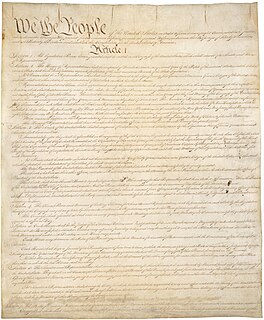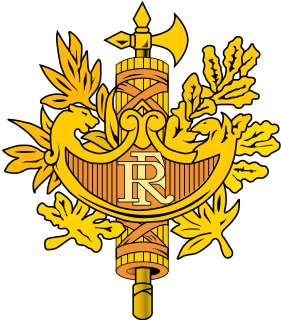
The politics of Ecuador are multi-party. The central government polity is a four-yearly elected presidential, unicameral representative democracy. The President of Ecuador is head of state and head of government on a multi-party system, and leads a cabinet with further executive power. Legislative power is not limited to the National Assembly, as it may to a lesser degree be exercised by the executive which consists of the President convening an appointed executive cabinet. Subsequent acts of the National Assembly are supreme over Executive Orders where sufficient votes have been cast by the legislators. The judiciary is independent of the executive and the legislature. Ecuador is also considered a constitutional republic.

The politics of the Republic of Peru takes place in a framework of a unitary semi-presidential representative democratic republic, whereby the President of Peru is both head of state and head of government, and of a pluriform multi-party system. Executive power is exercised by the President and the Government. Legislative power is vested in both the Government and the Congress. The Judiciary is independent of the executive and the legislature. The Economist Intelligence Unit has rated Peru as "flawed democracy" in 2016.

The United States Constitution is the supreme law of the United States. The Constitution, originally comprising seven articles, delineates the national frame of government. Its first three articles embody the doctrine of the separation of powers, whereby the federal government is divided into three branches: the legislative, consisting of the bicameral Congress ; the executive, consisting of the President ; and the judicial, consisting of the Supreme Court and other federal courts. Articles Four, Five and Six embody concepts of federalism, describing the rights and responsibilities of state governments, the states in relationship to the federal government, and the shared process of constitutional amendment. Article Seven establishes the procedure subsequently used by the thirteen States to ratify it. It is regarded as the oldest written and codified national constitution in force.

Article Three of the United States Constitution establishes the judicial branch of the federal government. Under Article Three, the judicial branch consists of the Supreme Court of the United States, as well as lower courts created by Congress. Article Three empowers the courts to handle cases or controversies arising under federal law, as well as other enumerated areas. Article Three also defines treason.

The Federal Government of the United States is the national government of the United States, a federal republic in North America, composed of 50 states, a federal district, five major self-governing territories, and several island possessions. The federal government is composed of three distinct branches: legislative, executive, and judicial, whose powers are vested by the U.S. Constitution in the Congress, the President, and the federal courts, respectively. The powers and duties of these branches are further defined by acts of congress, including the creation of executive departments and courts inferior to the Supreme Court.

The District of Columbia Voting Rights Amendment was a proposed amendment to the United States Constitution that would have given the District of Columbia full representation in the United States Congress, full representation in the Electoral College system, and full participation in the process by which the Constitution is amended.

The Judiciary Act of 1789 was a United States federal statute adopted on September 24, 1789, in the first session of the First United States Congress. It established the federal judiciary of the United States. Article III, Section 1 of the Constitution prescribed that the "judicial power of the United States, shall be vested in one supreme Court, and such inferior Courts" as Congress saw fit to establish. It made no provision for the composition or procedures of any of the courts, leaving this to Congress to decide.

The Supreme Tribunal of Justice is the highest court of law in the Bolivarian Republic of Venezuela and is the head of the judicial branch. As the independence of the Venezuelan judiciary under the regime of Nicolas Maduro is questioned, there have recently been many disputes to whether this court is legitimate.

The Congress of the Republic of Peru is the unicameral body that assumes legislative power in Peru. The congress consists of 130 members (congresistas), who are elected for five-year periods in office on a proportional representation basis.

The Republic of Peru is a unitary state and a semi-presidential representative democratic republic with a multi-party system, The current government was established by the 1993 Constitution of Peru. The government is composed of three branches, being the executive, judicial, and legislative branches.
The 1994 amendment to the Constitution of Argentina was approved on 22 August 1994 by a Constitutional Assembly that met in the twin cities of Santa Fe and Paraná. The calling for elections for the Constitutional Convention and the main issues to be decided were agreed in 1993 between President Carlos Menem, and former president and leader of the opposition, Raúl Alfonsín.

The Government of the Philippines is the national government of the Philippines. It is governed as unitary state under a presidential representative and democratic and a constitutional republic where the President function as both the head of state and the head of government of the country within a pluriform multi-party system.
The Constitution of the State of New Hampshire is the fundamental law of the State of New Hampshire, with which all statute laws must comply. The constitution became effective June 2, 1784, when it replaced the state's constitution of 1776.

The Constitution of the State of Oklahoma is the governing document of the U.S. State of Oklahoma. Adopted in 1907, Oklahoma ratified the United States Constitution on November 16, 1907, as the 46th U.S. state. At its ratification, the Oklahoma Constitution was the most lengthy governing document of any government in the U.S. All U.S. state constitutions are subject to federal judicial review; any provision can be nullified if it conflicts with the U.S. Constitution.

The Judiciary of Portugal is a system of courts that together constitute one of the four organs of Sovereignty as defined by the Portuguese Constitution. The courts are independent from the other three Portuguese organs of Sovereignty.

The Supreme Court is the highest court in Spain for all matters not pertaining to the Spanish Constitution. The court meets in the Convent of the Salesas Reales in Madrid and consists of a president and an indeterminate number of magistrates, appointed to the five chambers of the court.

The politics of France take place with the framework of a semi-presidential system determined by the French Constitution of the French Fifth Republic. The nation declares itself to be an "indivisible, secular, democratic, and social Republic". The constitution provides for a separation of powers and proclaims France's "attachment to the Rights of Man and the principles of national sovereignty as defined by the Declaration of 1789."

The Constitution of Djibouti was ratified in 1992 and amended in 2010. The constitution is divided into 13 titles which together contain 97 articles.

A constitutional referendum was held in Peru on 9 December 2018 alongside the second round of gubernatorial elections.
The 2019 Mongolian constitutional crisis started with the Mongolian Parliament adopting an unprecedented law on March 27, 2019 empowering the National Security Council of Mongolia to recommend the dismissal of judges, prosecutors and the head of the Anti-Corruption Agency. The law, proposed by President Khaltmaagiin Battulga, was ratified by a majority of the ruling Mongolian People's Party which holds 65 out of 76 seats in the State Great Khural. The opposition Democratic Party as well as a minority of MPP parliamentarians and a number of previous members of parliament and prominent lawyers have criticized the law as undermining Mongolia's constitutional separation of powers between the legislature, executive branch and judiciary and threatening Mongolia's democracy.




















